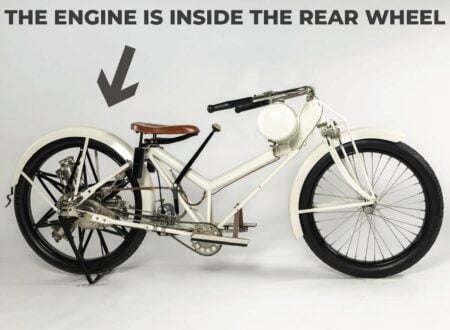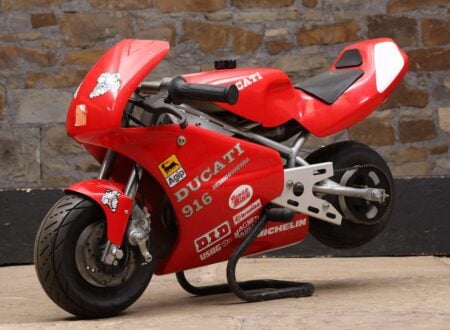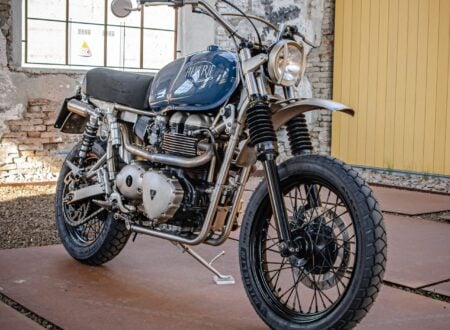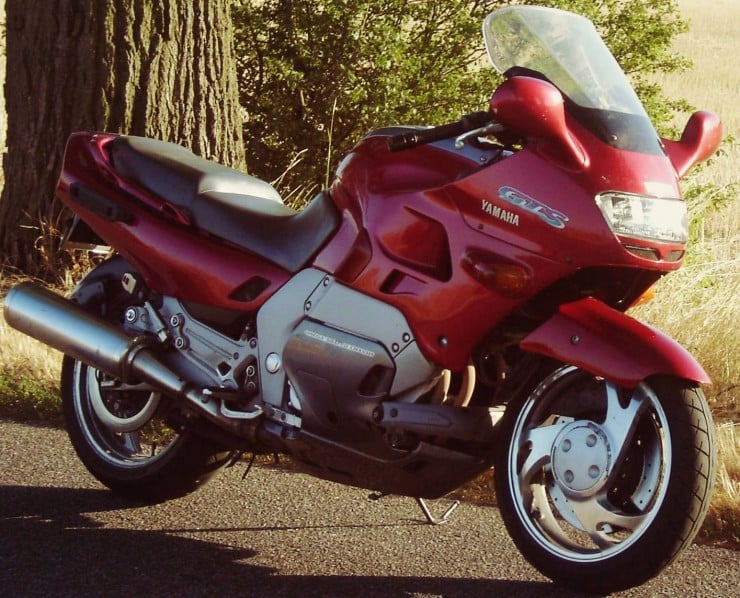
This is the fourth piece in a series on Silodrome written by the talented Jason Cormier, Jason is a writer, an avid motorcyclist, a Ducati die-hard, and a shadetree mechanic based in Montreal. He’s the editor of Odd-Bike.com, a unique website that showcases the history of rare and unusual motorcycles from around the world.
If you’ve spent any amount of time reading my work here on Silodrome or over on my website OddBike, you’ll be aware that I tend to favour independent thought and unique approaches to the design and construction of motorcycles. The mandate for my work on this site, such as it is, is to profile rare and unusual machines – with a particular eye towards unique technical qualities.
One element I have touched upon in the past is the proliferation of unique front suspension designs that are arguably superior to the “traditional” telescopic fork. There are a few brave engineers, designers and inventors who have dared to question the hegemony of the fork and propose a better solution. One of the most prominent, and perhaps the most misunderstood, is James Parker. Parker was one of the first inventors to achieve what many backyard tinkerers only dream of – to have his design adopted by a major manufacturer and put into mass production. His efforts are thus one of the best-known contributions to alternative front suspension design. Unfortunately Parker learned the hard way that the difference between conception and production can be significant, and that the design process within a major manufacturer is far from straightforward.
But first we must discuss why forks are bad, and why you should consider the alternatives.
The template for the modern fork has existed since the 1930s, when Nimbus introduced the first hydraulically damped fork – Scott enthusiasts might interrupt to point out that the Alfred Angas Scott introduced the first telescopic fork before that, but Nimbus was the first to introduce the oil-filled damping mechanism we now take for granted. BMW adopted the technology shortly after, then Norton got on board, and the rest is history. Adoption wasn’t universal for several decades but by the 1960s teleforks were more or less ubiquitous in production and racing. While crude by modern standards, these early designs set the pattern – chrome stanchions sliding within hollow legs, suspended by coil springs, with internal hydraulic damping, clamped by a pair of triple trees hung from a steering head on the frame.
Since those early days manufacturers have improved rigidity, added finer damping control, and improved performance, but we still have to deal with the same problems that were encountered nearly 80 years ago. When forks compress, the wheel moves up and back – this alters the geometry of the bike dynamically, which is bad news for handling. Bolting the front wheel to a pair of spindly hollow tubes is a recipe for lateral flex – no matter how rigid the legs, axles and triples are. The travel of the stanchion is constantly hampered by stiction, which is the juddering, sticking motion of the slider as it binds and flexes under load. And there is the rather obvious but often overlooked issue of having a suspension that is raked out at an angle that does not match the direction of wheel travel. Modern forks are also heavy, complex, and expensive to manufacture.
Then there is leverage. Think of the forks as a pair of crowbars bolted to the frame of your motorcycle. The wheel wants to travel straight up under load, but it is attached to your crowbars (forks) at an angle to facilitate steering – the rake angle. Every time you hit a bump, you are levering those crowbars backwards, violently, which by the process of leverage is magnifying the forces being applied to the chassis. This means you need a large, stiff, heavy frame to deal with the suspension forces being applied by that pair of crowbars mounted to your front wheel, which must also be made large, stiff and heavy to resist the flexing they will inevitably suffer.
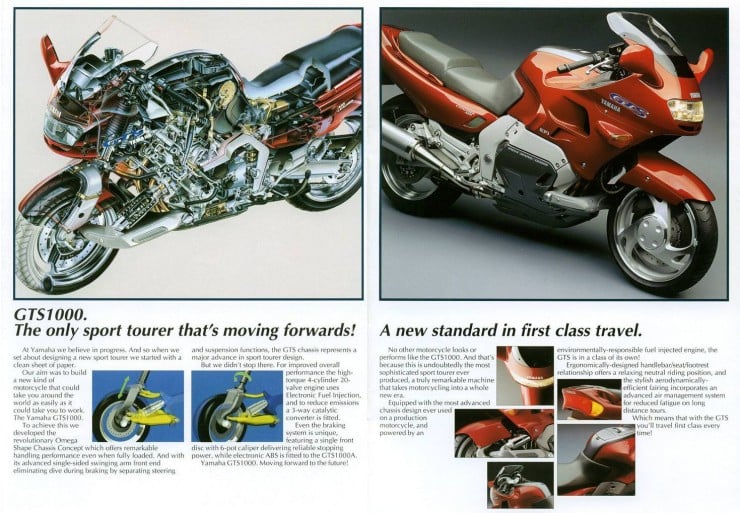
Even the most rigid fork and frame assemblies, like you would find in MotoGP, are plagued by flex and chatter issues. Dealing with the problem has become a matter of tuning for flex – maintaining a certain amount of deflection to act like a rudimentary suspension at the limits of wheel travel. If that sounds crude and barely controlled that’s because it is – tuned flex in chassis design is as subjective as it is mysterious and it remains a major problem in racing. Top level teams are often attempting to balance frame flex with suspension flex, where one will compensate for the other, all the while trying to tailor the machines to the preferences of the individual riders.
Is your head spinning yet?
In engineering terms, there are more strikes against the telescopic fork than there are positive points. So why do we continue using them?
Generations of riders have learned to accept the flaws and shortcomings of telescopic forks as the inherent qualities of a motorcycle in motion. Reams of literature and study have been devoted to working around the glaring issues present in slapping a giant pair of heavy, spindly levers onto the front of your bike that modify the suspension geometry every time you hit a bump or touch the brakes. Pick up any road racing or sport riding manual and a significant portion of the lessons will be devoted to riding around the problems caused by those damned forks. You must carefully modulate throttle in turns to maintain weight balance and never, ever chop the throttle or apply the brakes mid-corner lest you end up upsetting the delicate dynamic balance and running off the road (or at least pogoing around like a ham-fisted squid). Hard trail braking into a turn is a technique reserved for the pros or the foolhardy.
Why have we come to accept these shortcomings as the norm? Why do we devote so much breath, paper and practice to working around the flaws when better alternatives are already available, and have been available for decades?
Familiarity is an important element. Virtually every rider on the road have developed their skills around the flaws of the fork. We learn the dynamics, the suspension feedback, and how to sense the limits of traction within the system we are accustomed to. Take away those dynamics and most riders are out of their element – they no longer feel the same points of reference they are used to, and will often complain about an objectively better design simply because they are not accustomed to it. Subjective elements come into play and hamper progress. Conservatism begets conservatism: we are so used to forks that we are hostile to better alternatives because they feel alien, so we stick to what we are familiar with and never try to progress beyond refining the existing frameworks.
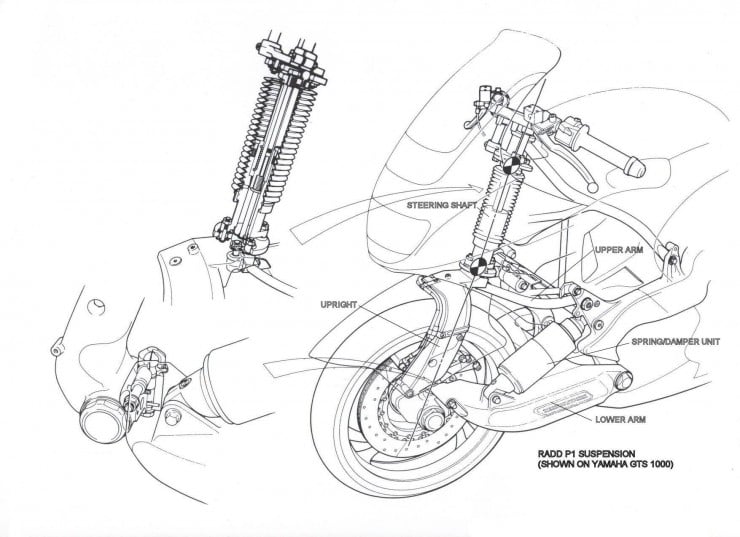
Finally there are the considerations of mass production. We’ve built millions of motorcycles with telescopic forks. We have huge swaths of industry dedicated to designing, manufacturing, fixing, and modifying them. We understand them better than any other system by virtue of having used them universally for so long. Reinventing motorcycle suspension is a tricky business when billions of dollars of manufacturing, servicing and racing are dedicated to one particular way of doing things. Never mind that motorcycle buyers in general are a conservative lot who often are averse to new ideas, particularly ones they don’t fully understand. If you don’t believe that, spend some time reading the comment threads around any radical new model or technology announcement.
James Parker thought there must be a better way. So he designed one.
Parker studied Industrial Design at Stanford University. While not formally trained as an engineer, he has a great deal of hands-on experience with motorcycles. During the early 1970s he ran a Hodaka dealership and dabbled in racing. He developed a penchant for innovative design early on. In 1971 he built a 120-pound riveted-aluminum monocoque-chassis Hodaka racer. In 1975 he developed a rising-rate single-shock rear suspension, and incorporated it into a trellis frame design for a Yamaha 500cc four-stroke single. Meanwhile he was racing RD350s at the club level and riding for Motorcyclist magazine’s endurance racing team.
During his time on the track in the 1970s Parker noted the weak point that was common in all two wheeled machines – their forks. While engine, chassis and tire design was moving forward in leaps and bounds, forks remained more or less unchanged and were remarkably unsophisticated considering the power and speed that machines were achieving during this era. In the late 70s a forward-thinking solution was put forward by the French ELF racing team and their radically different ELF X prototype.
The ELF series of experimental racers began in 1978 when the motorsports arm of the French petroleum company began funding a series of highly advanced motorcycle chassis concepts that would be campaigned in endurance racing. The project began when ELF offered Alpine / Renault engineer Andre de Cortanze the opportunity (and the budget) to build a design that applied automotive suspension principles to a motorcycle, fulfilling de Cortanze’s design goals of inherent anti-dive, a much lower centre of gravity, and the elimination of the traditional frame.
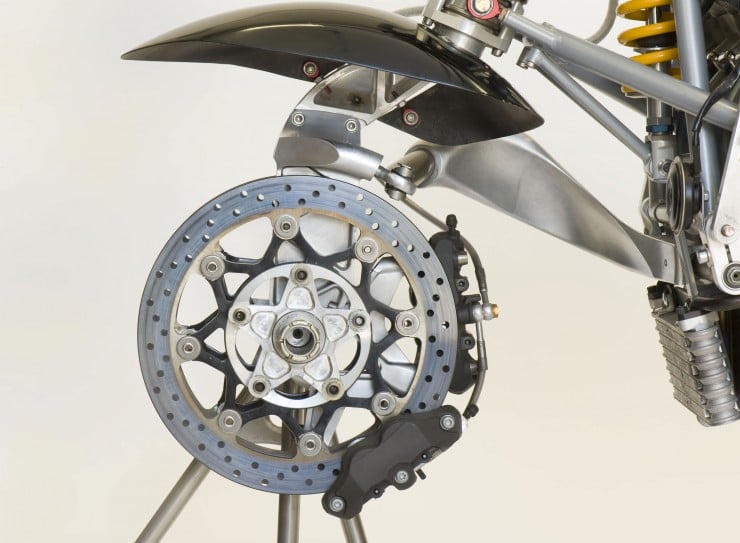
The result was the ELF X, which was unveiled at the 1978 Paris Salon. Powered by a Yamaha TZ750 two-stroke four, the X was unlike anything else on two wheels. It featured a double-link front suspension, with single-sided wheel mounting on both ends to facilitate easy wheel changes in endurance racing. A lower swingarm was suspended by a single coilover shock, while a second parallel arm supported a steered upright. Steering was operated via a series of rods and linkages connected to the controls.
Without the suspension forces being channelled through a traditional front end into a steering head, there was no need for a frame connecting the two ends of the bike together – the crankcases served as the de facto frame, with a modest spar bolted to either side. In his quest for a lower centre of gravity de Cortanze saw fit to mount the fuel tank under the engine and route the exhaust chambers over the top, predating Honda’s ill-fated 1984 NSR500 which would attempt the same layout in Grand Prix racing.
The X was so completely unlike anything else that it established a new goalpost for innovation in chassis and suspension design. The future was here. And the X was only the beginning. A series of increasingly advanced machines would be commissioned by ELF over the following decade, but the X was the design that set the template for what was on the horizon. By 1979 Honda was on board to supply four-stroke endurance racing engines to the ELF team from the 1980 season on, establishing a partnership that would run until 1988.
Like many designers Parker was extremely interested in what de Cortanze and ELF were doing and set about reverse-engineering the X’s front suspension design. He began by sketching the machine, pencil on paper being his preferred method of de-constructing and understanding a design. After examining the front suspension in detail he realized that there would be one considerable flaw in the performance of the front end: it would be affected by bump steer.
Bump steer is an undesirable result of interactions between suspension movement and steering geometry that is far more common in automotive design than it is in motorcycles. The process is one where the travel of the suspension can introduce steering inputs and deflection of the front wheels, usually due to the geometric layout of the steering linkages, or due to loose joints, bushings or bearings that introduce free play into the steering system. Bump steer is always present to a small degree in four-wheeled vehicles, but is generally offset by the stability of the wheel on the other side. It can affect any vehicle that uses an indirect steering linkage.
As most conventional motorcycle designs use direct steering, where the handlebars are connected to the front suspension and act upon it without any linkages or indirect mechanisms, you don’t have the problem of bump steer at all. Put simply: forks don’t bump steer. You may experience deflection of the front wheel by a bump in the road, but that deflection is caused by factors like flexing rather than basic geometry and will not steer the wheel independently of where the controls are pointing.
Take away the headstock and the direct steering and replace it with a series of indirect linkages – like you would on, say, an experimental motorcycle that uses a multi-link front suspension – and you may well introduce bump steer. You can try to mitigate the effect by carefully aligning the arms and maintaining a constant length and parallel movement of all the arms through the travel of the suspension, but this is difficult to do within the tight confines of a motorcycle. Compromises are necessary to make the handling stable. Parker realized that the geometry and steering system present on the X would make it prone to bump steer. He proved to be right, and subsequent ELF designs addressed the issue.
Finding the problem is easy enough. Fixing it is another matter. Parker’s solution was to eliminate the indirect steering mechanism. Rather than have a series of rods, bell cranks and joints connecting the controls to the steering arm, he developed a direct steering link between the handlebars and the front wheel. It would be the best of both worlds – you’d get all the advantages of the double-link front suspension with the steering simplicity of a conventional fork. This idea would become the basis of his subsequent work. With his time split between racing and building, Parker noted that he wasn’t able to complete all of his projects. Feeling that he wasn’t the greatest rider on the track, and that a season on the track cost about the same as securing a patent, he made the decision to retire from racing to focus on developing his front suspension design.
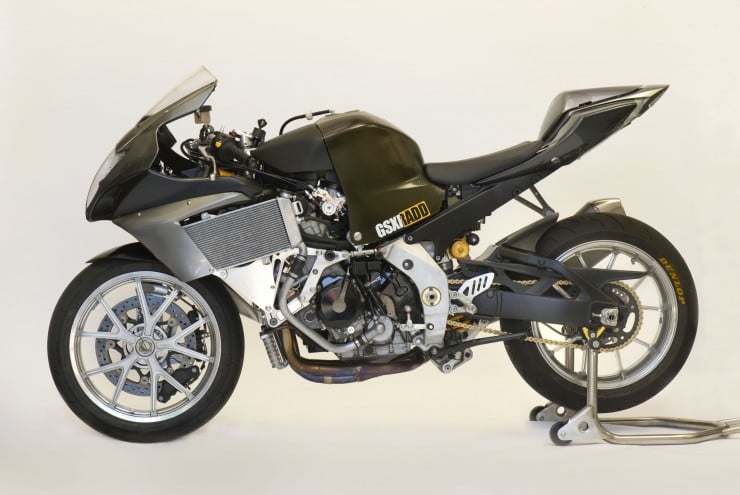
Parker’s design was an evolution of other double-arm designs, reworked to eliminate bump steer. The lower arm resembles a rear swingarm and is suspended by a coilover shock mounted to the front of the frame, with a single-sided mounting for the wheel. The upright was considerably longer in Parker’s design than in de Cortanze’s with the top arm sitting above the wheel rather than fitting within its diameter. The key to Parker’s design was the introduction of a telescopic steering column which eliminated the indirect steering mechanism. This column was a tube around a slider that was locked and incapable of rotating, running on linear bearings and bolted to the top of the upright steering arm. The column was connected to the controls with a conventional-looking top yoke, supported by a subframe.
An important note to address a major peeve of mine: Parker’s design is not hub centre steered, despite dozens of articles declaring it as such. It is a steered upright design, where a vertical control arm turns the wheel: it falls into the same category as Julian Farnam’s FFE 350 previously featured here on OddBike. Yamaha referred to the system as “hub link steering”. Calling it hub centre steering is akin to referring to a certain suspension component as a “dampener”: close, but completely wrong.
Parker dubbed his company and his system Rationally Advanced Design Development – RADD. He applied for a patent in 1982 and finished his first prototype in 1984. The first RADD machine was built around a Honda XL600R engine and frame, the donor bike provided by Honda USA. Once the machine was completed he succeeded in securing a test at Willow Springs with a young dirt tracker and Superbike rider by the name of Wayne Rainey on hand to test the machine.
The RADD front end proved to be a success. Rainey praised the handling and feedback of the front suspension. Honda Japan wasn’t interested, however – at that point they were already involved with ELF and weren’t interested in another alternative design. The Japanese higher ups nixed the deal to donate the XL600R to Parker, forcing him to pay for the machine he had now modified beyond recognition. The machine was now his and his alone, and after Honda’s rebuff he set about canvassing the US offices of the other Japanese manufacturers to see if anyone else would be interested in the RADD chassis.
It was during this period that Parker met John Porter while introducing the RADD prototype to Yamaha USA. Porter was interested in what Parker had created and became an early supporter of the RADD project, promoting the idea within the US Yamaha offices. It was around this time that Parker had a fateful idea – Motorcyclist would be celebrating its 75th anniversary in July 1987. Parker approached his colleagues at the magazine and asked them: if he were to build a futuristic one-off machine using his RADD suspension, would they feature it on the cover of their anniversary issue? Motorcyclist agreed, and Parker set about fulfilling his promise – he had five months to build something spectacular enough to be worthy of the magazine’s anniversary cover feature.
John Porter campaigned the idea at Yamaha USA and succeeded in securing a FZ750 for the project. Parker built the chassis, modifying the FZ frame beyond recognition to accommodate the front wishbones. The basic design was the same as it had been on the Honda RADD, but the details were refined and the components made more presentable. The resulting chassis had a highly polished appearance that made the machine look like a production effort, not the product of a lone man in Santa Fe.
GK Design International, the California branch of a Japanese design company, provided styling design and built the bodywork. They succeeded in creating sharp-edged, forward looking styling that was perfectly in tune with the innovation of the chassis. Rather than totally streamline the machine GK left a gap between the belly pan and the top fairing to showcase some of the chassis modifications and accentuate the unusual front end. The result was modern, clean, and quite handsome. It was a far cry from the staid-looking FZ that served as the donor for the exercise.
The resulting machine, dubbed the RADD MC2 (MC “Squared”), was completed in time to be shown at the 1987 Milan Motorcycle Exhibition. As promised, the MC2 was featured on the cover of Motorcyclist. It was an immediate sensation. Here was the future, a machine that truly looked like it was from a sci-fi feature. But this was no styling exercise: this was a running, rideable machine that sought to fix the problems of the front fork and make an alternative front suspension that worked. The magazine used the tagline “RADD/YAMAHA 750 MC2 – It’s HOT. It’s Here. It Works. We Ride It.”
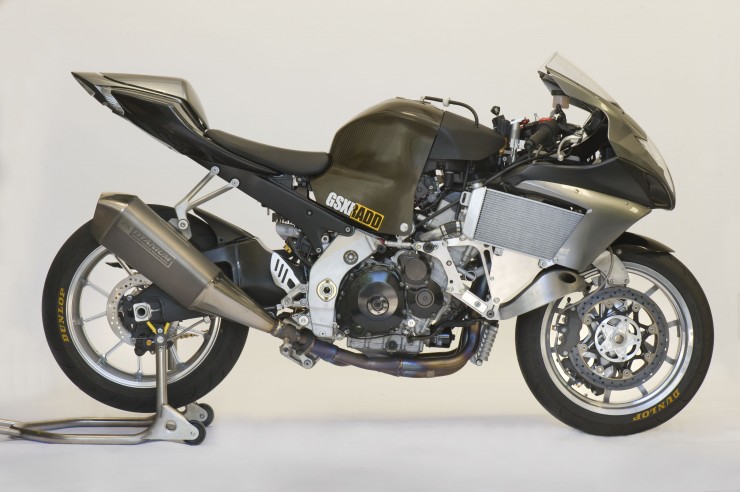
The reaction to the Motorcyclist feature was huge, and quite unexpected. Good press and positive reactions helped propel the project onto the international stage. The machine was given cover space by seven other magazines. People began contacting Yamaha directly to inquire about this wild new concept machine, and find out if they had any intention of producing it.
But there was a problem. Yamaha Japan was completely unaware of the MC2. It was an unofficial project done entirely through RADD and Yamaha’s USA office. The public and some members of the press just assumed it was an official Yamaha design, given the coverage and the quality of the machine. Even Motorcyclist referred to it as the “RADD/YAMAHA”. No independent project had received that level of coverage before. This confusion served as an important catalyst for Parker’s future with Yamaha.
It was shortly after the MC2 hit the press that Yamaha Japan began working on the Morpho, a non-running 400cc concept machine that incorporated a RADD-like suspension into an official project. Yamaha, however, didn’t secure Parker’s approval for the project. The Morpho was built without his knowledge. It appeared that Yamaha was trying to usurp the success of the MC2 and take control of the concept by making it their own. Not only that, but the Morpho incorporated another one of Parker’s innovations – a quick-change rear wheel assembly. Parker negotiated a deal with Yamaha to license his designs before the concept was released to the public in 1989.
The Morpho proved to be a sign of what was to come, both in terms of politics and in terms of design – Yamaha adapted Parker’s principles but modified them on aesthetic grounds for the Morpho, in such a way that performance of the front suspension would be compromised. That might not have been a problem on a static concept machine, but it would be an issue if the suspension was ever put into mass production. Yamaha was being rather liberal with what they thought they could do with Parker’s design, a situation made worse by the fact that the company did not have any front suspension design department. Yamaha chassis engineers traditionally had designed the machine up to the steering head, then outsourced the fork production to contractors and suppliers.
Meanwhile Yamaha Europe was clamouring for a new machine, a high specification sport tourer. The brief was that the bike had to have antilock brakes, fuel injection, and a catalytic converter, and preferably a new suspension. The requirement for a new suspension was translated into a demand for the RADD chassis. This brief, known internally as project 069, would become the genesis of the Yamaha GTS1000.
Given his difficulties in dealing with Yamaha, Parker decided to hire a Japanese/American consultant. Glen Fukuda became Parker’s liaison with the company and a critical part of his relationship with the company. Parker learned early on that as a non-Japanese outsider, he would never be fully accepted into the company and given the proper level of input. Fukuda smoothed things over and allowed a greater level of discussion, but Parker was never entirely at ease. He didn’t feel like a full member of the team, despite being critical to the adaptation of the RADD suspension to production. He was kept out of the workshops and only allowed to speak to higher ups. He dealt with executives and high-level engineers, but never the people who were actually building the prototypes. He is a hands-on guy, a builder as well as a designer, but at Yamaha he wasn’t allowed to speak to the people who were actually spinning wrenches. There were incidents where he was presented with prototypes in a boardroom, with no tools or technicians on hand to remove the bodywork so he could examine the components. He had no input on the styling, marketing or features of the machine. His design was licensed and he consulted the company as best he could, but he was kept out of the nitty-gritty elements of the design process.
It was during this process that Parker noted a problem. Like on the Morpho the swingarms had been made unequal length for packaging reasons, mainly so that the upper arm would clear a radiator mounted in the conventional location. If you compare the MC2 with the GTS you will note the significant difference in the geometry of their front ends. Making the upper arm shorter would bring the top of the steering upright backwards as the wheel rose. The top pivot would move backwards more than the lower one, rather than both rising straight up in parallel. The rake and trail of the front end would thus increase, causing the steering to get heavier. Parker was aware of this problem and had designed his suspension accordingly, but Yamaha had missed this in their quest for “better” packaging. Parker warned Yamaha of this problem but his concerns were ultimately ignored.
The GTS1000 was unveiled in 1992 to widespread amazement. Here was the future, in production form, available at your friendly local Yamaha dealer. A series of (sometimes corny) television ads were released to announce the death of the telescopic fork, now that Yamaha had introduced the future of suspension design – yours for $12,999 USD.
The engine selected for the GTS was the well-regarded 1002cc 20-valve four cylinder taken from the second generation FZR1000 EXUP. The double-cam, five-valve head was a signature of Yamaha from the mid 1980s right up until they dropped the idea in 2007. While the FZR had a reputation for being a ferociously fast and obscenely powerful superbike, the GTS needed a smooth and powerful engine that befitted its high-speed sport touring goal. To that aim the 75.5x56mm mill was heavily neutered to boost midrange and “detune” the top end. It had reworked heads, tamer cams, and a much lower compression ratio (10.8:1 instead of 12:1) that lopped about 40hp off the top, for a grand total of 100hp at 9000rpm and 78 lb/ft at 6500. An entire generation of hot-rodding oddball sport touring riders have been thwarted by the significant modifications – it takes a lot of work to bring a GTS back up to FZR levels of ludicrous power. The FZR’s five-speed close-ratio transmission and chain final drive were left unchanged. The Mikuni carburettors used on the FZR were ditched in favour of a closed-loop Nippon fuel injection. The four-into-one exhaust system featured a 3-way catalytic converter, the first for a motorcycle and a feature that wasn’t standard on two-wheeled machines until well into the 2000s.
The finished GTS chassis was unlike anything else in production. Because there were no suspension forces being channelled high into the headstock, the GTS used a low and sleek “Omega” frame, so called because it resembled the Ω symbol in profile. The pivots of the front and rear swingarms were connected via an alloy spar on either side of the crankcase, braced with additional beams running beneath the engine on either side. Removable panels allowed for easier access to the engine for maintenance. The steering column, upper wishbone, and rider controls were supported by a tubular steel subframe hidden under the bodywork. The rear suspension was conventional, with a beam-spar alloy swingarm and a rising rate monoshock linkage (Monocross in Yamaha parlance). The GTS1000A (and all North American market GTSs) featured electronic ABS, which was still a long way from becoming standard fitment on motorcycles.
The real party was at the front, where the wheel was suspended on an alloy swingarm with a linear-rate shock offset to the left of the bike. The steering upright was angled back and connected to the parallel upper swingarm that was tucked in behind the bodywork. A telescoping steering column sheathed in a rubber gaiter connected the upright to the controls. The front wheel used a single-sided mount with a single 330mm brake disc mated to a huge six-piston caliper designed specifically for the GTS. The result was truly unlike anything else that had ever been put into production. You could (and still can) spot a GTS a mile away when you saw that peculiar front end, C-shaped frame, and three-spoke front wheel.
By modern standards the styling was relatively conservative but in 1992 it was quite polarizing. It was either handsome or ugly depending on who you asked. The appearance erred more towards “sport” than “touring”, as did the seating position. Wind protection was helped by a tall windscreen but hampered by a narrow profile by fully-enclosed bodywork ahead of the rider’s knees. Two sizes of Krauser hard bags were available as a cost-extra option. The lack of a frame above the engine cluttering things up allowed for the placement of a small luggage compartment above the fuel tank and airbox.
Reviews were mostly positive, most noting the stability of the chassis and the lack of brake dive, but there were a few issues. The most common complaint was the price – despite the high specifications and RADD front end, $13,000 for a motorcycle in the early 1990s was a tough pill to swallow and forced inevitable comparisons to less expensive “conventional” machines from other marques. There were a few niggling points that dedicated touring riders noted: the relatively small 20 litre fuel tank (and high fuel consumption) which limited range, the chain final drive instead of a low-maintenance shaft, the lack of wind protection and significant buffeting in the cockpit, and the lack of standard luggage. Riders who hoped for an FZR with a fancy suspension and comfy seat were disappointed by the heavily detuned motor which didn’t seem to gain as much midrange punch as it lost in eyeball-flattening top end. The GTS was also heavy, weighing in at 550 lbs dry. It was quick and handled well, but it wasn’t going to blow away superbikes on the backroads. A few people wondered aloud why this was better than the cheaper, faster and much-loved FJ1200.
To the GTS’s credit, many noted that high-speed stability was excellent and you could trail brake without upsetting the chassis or overloading the front wheel. But most reviews complained of heavy steering and vague feedback from the front end, particularly during low speed manoeuvring, just as Parker had predicted. It resulted in a disappointing feel that made the already heavy machine seem even more cumbersome. Some thought it was due to conservative engineering in the unproven front end, erring on the side of slow and overbuilt to keep things safe. Many unfairly attributed these characteristics to the RADD front end and ultimately Parker himself, unaware of how Yamaha had messed up the execution. The general attitude was that the GTS was undeniably different, but it wasn’t worth spending several thousand more put the motorcycle of the future in your garage. The performance of the GTS front end didn’t inspire many to enthusiastically abandon the telescopic fork as had been hoped. It was good, but not good enough to unseat long-standing tradition – and in the minds of reviewers and buyers, it was not good enough to justify the significant price premium it commanded.
Sales were so poor in the North American market that the GTS was pulled from showrooms in 1994. It continued to be sold in small numbers in Europe until 1999 but never became anything more than an expensive curiosity, a cult bike that earned a loyal following but was generally forgotten by the motorcycling public. Some interesting attempts at racing what was ostensibly a touring machine were made. An attempt was made to race a heavily modified GTS at the Isle of Man TT in 1994 – the machine ultimately placed 8th in the F1 class and was noted for dragging its front swingarm through left-hand turns! American Roadracing editor Brian Catterson built a GTS, which he nicknamed Shamu, to compete in AMA SuperTeams endurance racing in 1995 – you can still order the racing bodywork made for Shamu from Airtech.
Despite the hopes of all involved, and the heavy-handed death-of-the-fork marketing done by Yamaha, design conservatism and the maintenance the status quo continued. Tradition was reinforced by the GTS rather than mitigated by the innovation it displayed. While it had a loyal fanbase, the machine was generally regarded as a failure and was pointed to by the public and manufacturers alike as an example of why alternatives to the fork were untenable and undesirable. By trying to break out of tradition, Yamaha had inadvertently reinforced it. “We can’t do that. Look at what Yamaha did – you saw how things turned out for them.”
But hindsight isn’t always 20/20 – it is unfair to blame the failure of the machine entirely on the suspension, because that wasn’t the case at all. The front end was one of the high points of the machine even if it wasn’t a major breakthrough in terms of performance (and the function was compromised by Yamaha’s meddling). The failure was more due to the price point, the futuristic styling, the weight, and the odd marketing. It was a machine that didn’t quite fit into the category it was aimed at. It targeted well-heeled veteran touring riders, but didn’t offer any of the characteristics they needed. It aimed to sell the future to older, more conservative buyers.
The real victim of the failure of the GTS1000 wasn’t Yamaha. It was James Parker. His name would become directly associated with the GTS and his RADD design would be unfairly critiqued through the sales failure of the GTS. Even with the less-than-ideal geometry the RADD was a sound design and worked better than any befork’d machine it was tested against. The GTS worked quite well despite the flaws in the execution, a fact that has been forgotten in the years since it was discontinued. Negative press and harsh criticisms have a tendency to bubble to the surface of the recollections of the average person. Few have remembered the good points.
Despite the poor reception of the GTS, Parker didn’t abandon his design and set about refining his ideas in the mid-1990s. In 1995 he built the RATZ, with an updated RADD chassis built around a Yamaha TZ250 two-stroke engine. Ironically when he applied for a new patent Parker was rebuffed by the patent office for infringing on the Yamaha patents filed for the GTS – once he demonstrated that the Yamaha system was based on his earlier patents all was cleared up.
The front wishbones on the RATZ were heavily curved and tucked up high into the bodywork to ensure good ground clearance and to further centralize the mass. The frame was a machined alloy Omega spar with a beam subframe supporting the steering head and shock mount. Everything outside of the motor was developed and built by Parker, including the single-sided rear swingarm with a special non-eccentric chain adjustment to maintain a constant ride height when setting the chain tension. Other innovations included a twin-disc setup within the front wheel hub (a single carbon disc was tested as well) and a rear-mounted radiator fed by two air ducts that ran the length of the bike. Parker refers to the RATZ as an interim machine, one designed “quickly” after the release of the GTS to improve upon his initial patent and apply a few new ideas. It was the first chassis that he built in its entirety without modifying an existing machine. He initially anticipated support from Yamaha but when that didn’t materialize he was forced to build the machine out of his own pocket.
That was effectively the end of his relationship with Yamaha, and a wake up call – he notes that in later projects he “didn’t have the same delusions” of getting official support from any manufacturers. Parker points out that during the development of the GTS there were two distinct camps within Yamaha – pros and cons. When the GTS failed to sell well “the cons won” and there was little desire to pick things up and try again. Parker came away from his experiences with Yamaha feeling alienated. He knows firsthand what goes on inside the Japanese companies, having seen the class structure and xenophobia that lurks beneath the surface. Despite this difficult experience he remains proud of the GTS and is quick to defend the design – and yes, he owns one himself.
In 2006 Parker began working on his fourth prototype and third revision of the RADD design which applied all the lessons he had learned over the past 20 years. He purchased a 2006 Suzuki GSX-R1000 and rebuilt it into what he calls the GSXRADD P3 (for Patent #3). The main spars of the frame are cut off, leaving only the lower mounts around the swingarm pivot. Skeletal milled alloy supports bolt to the front of the engine and serve as the mounting point for the front suspension. The radiators are mounted flat under the fairing on both sides to allow clearance for the new front end – cooling is actually improved over the stock setup. The lower swingarm, steered upright, and frame plates are CNC milled. The upper wishbone is fabricated from steel tubing, as is the front subframe supporting the upper end of the shock, steering mechanism and controls. Front suspension is via an adjustable Ohlins TTX36 coilover shock. The stock brake discs and calipers are mounted in parallel on the wheel hub, set inside a custom single-sided front wheel. A custom carbon fibre fuel tank places the fuel in a lower and more centralized position.
All told the front suspension is 13 lbs lighter than stock, with an additional 9 lbs shed with the new fuel tank, and the mass was centralized considerably versus a telescopic assembly. In spite of the extensive modifications and the substantial cost of the project, the front suspension is relatively simple and would lend itself well to mass production.
With the bodywork on there is little to suggest this is anything other than a normal GSX-R, until you notice the single-sided front wheel. The controls are in the stock position and nothing except the frame and front end is modified on the machine. The rake, trail and wheelbase values are identical to the stocker. Parker even engineered a modest amount of brake dive into the design so that it would feel familiar to riders accustomed to telescopic forks. It is ironic that Parker felt he needed to tune his setup to mimic the characteristics of a conventional fork to put riders at ease, but it proved to be a way to inspire confidence in testers who might otherwise be put off by the unique and unfamiliar dynamic qualities of a forkless motorcycle.
Provisions were made to accommodate a steering damper, so that all the variables and geometry are as close to the stock GSX-R as possible. The whole project is designed to allow direct back-to-back comparison with a stock GSX-R so that riders can immediately note the improvements over the stock setup. This was how the GSXRADD was shown in 2008, when Parker offered it up for testing at the Sandia Motorsports Park in Albuquerque, New Mexico, close to his Santa Fe home and workshop. A standard 2006 GSX-R1000 was offered for laps alongside the GSXRADD so that riders could directly compare performance.
All the testers noted that the system worked remarkably well, offering extremely light and precise steering that made the bike feel smaller than it really was. The steered mass of the RADD front end is much less than that of a forked machine, with only the wheel, brakes and steered upright moving rather than the entire front suspension. Stability was exceptional, even when the steering damper was removed – where the stock bike would be dangerous without a damper the RADD didn’t need it at all, despite sharing identical suspension geometry and tires. Feedback was noted as excellent, clearly better than the stock machine. Some minor issues were noted when the system was pushed hard during initial testing but they were quickly corrected, and overall the system worked remarkably well. Plans were begun to offer the conversion to the public for $50,000 USD.
Parker notes that since the financial crisis of 2008 the climate has changed considerably and interest in his design has waned. The economic meltdown put all of the marques into a conservative contingency mode and the inquiries into the RADD stopped. At this point Parker would like to discuss the matter with BMW: he thinks that they would have a better understanding of what he is trying to do, given their singular adoption of alternative front suspensions, and they might see the advantages of the RADD suspension over their current Duolever (nee Hossack) design.
Parker genuinely believes that his design is the best alternative to the fork out there, and the best front suspension possible for a road-going motorcycle. He just needs to convince the manufacturers and the public of this fact. He notes that the automotive world seems to be far more receptive to advances in design and engineering compared to the motorcycle industry, where we have spent decades rehashing and refining the same old designs without making any significant breakthroughs. We haven’t moved as far away from the concept of a bicycle-with-a-motor-attached as we’ve been led to believe. This is a common sentiment among those who are trying to do something different, something better. Despite appearances of progress, conservatism reigns supreme in motorcycle design – a fact made worse by a poor economy.
In recent years the GTS1000 has received a revival among riders seeking a unique and innovative sport touring mount. In December 2006 Britain’s Bike magazine declared the GTS their number-one pick for “Coolest Rare Bike”, noting:
“The Terminator films were still current when the GTS was launched and the single-sided front end had a firm futuristic look to it, blending into the clean, uncluttered, enclosing bodywork to give a glimpse of the biking in the future. Unfortunately the alien appearance, frankly excessive weight and a steep asking price limited sales – but they don’t matter one iota today. This is still ground-breaking and courageous engineering, with form following function and a fresh approach to design. The fact that it wasn’t the redefining success Yamaha had hoped for even adds to the appeal today, making it as cool for being a valiant failure as for being exclusive or irregular.”
Today the GTS has become a modern classic, an unusual and rare machine that has received far more praise than it ever did when it was still in showrooms. A new generation of owners are discovering the GTS without the stigma of an exorbitant price tag turning them away or inspiring unfair criticism. The styling has aged well, the engine is extremely reliable, and the front suspension proved to be very well engineered and nearly maintenance-free in the long term. Owners have become very proud of their unique machines and there is a strong support community for the GTS. It has become a cult classic, a motorcycle to watch in coming decades as demand creeps up for the few examples that remain on the road.
James Parker continues to operate out of his Santa Fe home and still writes for Motorcyclist. His most recent accomplishment was designing the chassis of the very well received Mission R electric superbike , whic was chosen as one of Time magazine’s 25 best inventions of 2013. The possibility of using a RADD front end on the R was discussed, but not pursued due to the engineering limitations of a small start-up company. The RATZ was recently exhibited at the New Mexico Museum of Modern Art as part of the exhibit 14,000 years of New Mexico Art, where it shared space with 12,000 year-old Clovis arrowheads and one of Robert H. Goddard’s rocket engines. Parker still holds hope that someone will adapt his newst RADD design for mass production. The difficulties he faced with Yamaha and the lack of follow up to the GTS project hasn’t deterred him from canvassing manufacturers and hoping that someone will be willing to take a risk, in spite the poor economic climate. Despite the setbacks he has faced Parker remains focused on his goal of creating the best front suspension design possible, something he believes he has achieved with the P3.
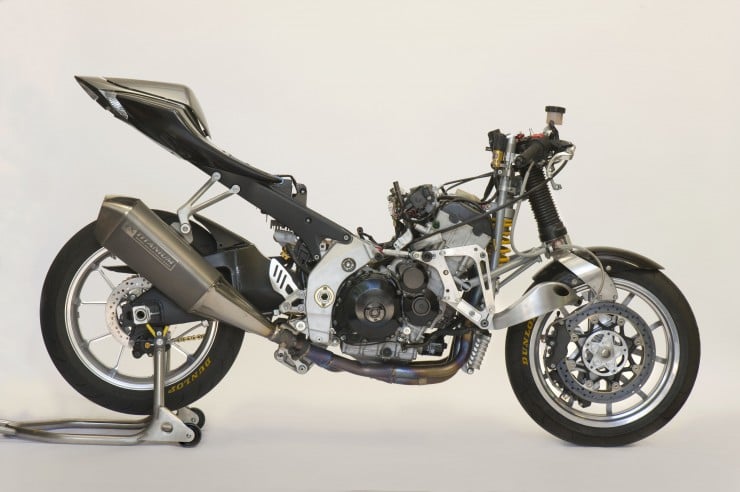
See more images here on Odd Bike.
Interesting Links
Ultimate Motorcycling on the GSX-RADD
GTS1000 Launch article from 1992
Yamaha GTS1000 documents and press material
A rather critical review of the GTS1000
Alan Cathcart on the ELF experimental racers
Mark Gardiner on the Mission R



